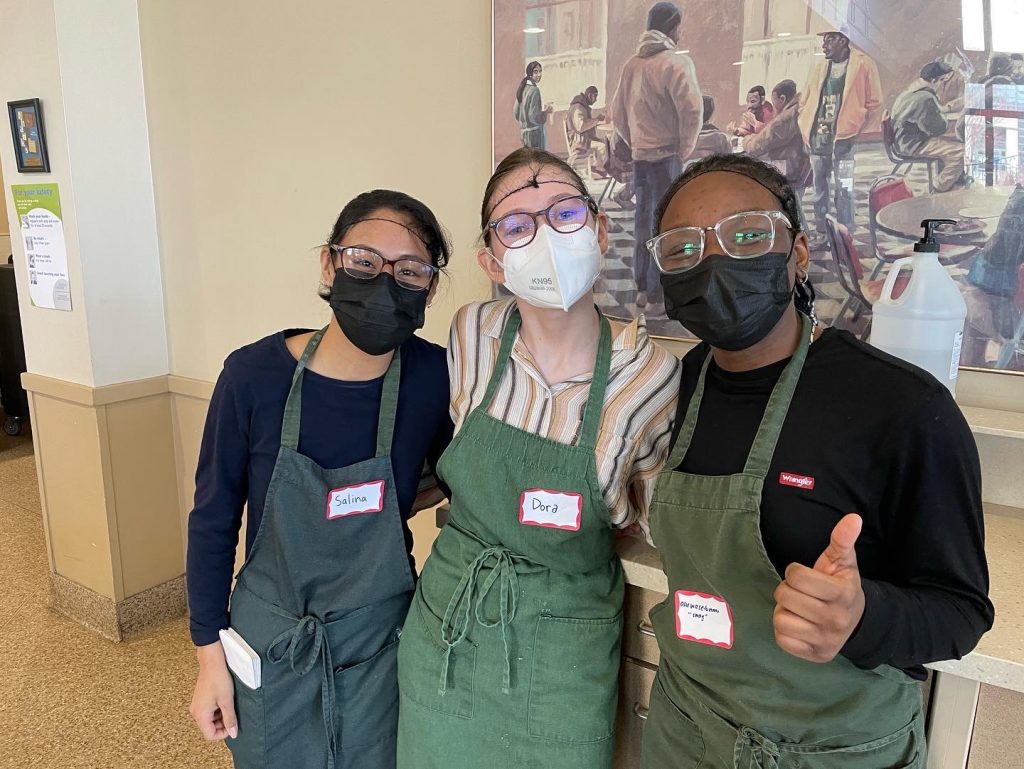This morning, some of us had the opportunity to serve at Our Daily Bread, a Catholic Charities Hot Meal Program. We arrived around 9 and began doing some of the prep work to have plates and to-go boxes ready and some tea bags tied together (so many tea bags!!). Right before beginning meal service, we did a small prayer and were all assigned tasks for the next two hours. As soon as the doors opened at 10:30, people came pouring in. I had done meal packaging before but serving was an entirely different experience. As I was serving, despite the rush of trying to make sure everyone got what they needed, it was so nice to be able to talk to people and see the looks on their faces when a plate of hot food was placed in front of them. We were only there for one day, but to see the connections employees and consistent volunteers had built with the people we were feeding was heart-warming and beautifully signified the community that can be built through food. While this is only one meal of the day, it is guaranteed food that is important to a lot of people, and I am grateful for the opportunity to be a part of one day of that experience.

Later in the afternoon, with our free time, some of us decided to go to the Inner Harbor. It was a gorgeous day, the weather was great, and there were tons of people walking, skating, and riding bikes. Some of us were tempted by the shops but opted to spend as much time as possible in the sun and warmth looking out at the water. We even walked up the stairs to Federal Hill Park and looked out over all of the boats in the harbor and the impressive skyline with notable landmarks like the Dominos Sugar factory sign. As a Maryland native, I had been to the Inner Harbor a few times on school field trips to the aquarium or science center and even on family outings, but I had an entirely new perspective this time.

Through our course, one of the materials we read was “A View From Federal Hill” by David Harvey, which details the history of the development of Baltimore, which areas were invested in, by whom, why, and how those investments panned out for the city. Long story short, investments in places like the Inner Harbor rely heavily on taxpayer dollars and claim to be supporting the local population and the city as a whole, but ultimately do not create sufficient opportunity or profit for the people in the city who really need it. Visiting Our Daily Bread and Inner Harbor on the same day brought stark contrast. How do we process and digest the fact that both situations coexist quite literally a mile away from each other? How could I enjoy the Inner Harbor knowing what it means for the city economy and for residents like those at Pleasant Hope who told us they never go there? How have I fed into this disparity through my own past tourism and is today only furthering that? How do we balance trying to see and enjoy the city while also keeping its deep-rooted issues in perspective?
I found myself in real internal conflict the entire time we were at the Inner Harbor and for the rest of the evening. With some of the illusion worn off simply from already having been there, it was even harder to press these thoughts and questions out of my mind without the distraction of a first-time experience. And I don’t really have answers to these, but it’s definitely food for thought and a core component of our course that I will be thinking about far after . “Why does food insecurity exist in 2022”, and to add to that, “especially when there are areas of clear wealth and excess in the same city?”. As I learn more through this class and am exposed to disparate experiences, it also makes room for more questions, for the outside world and for my role within it.